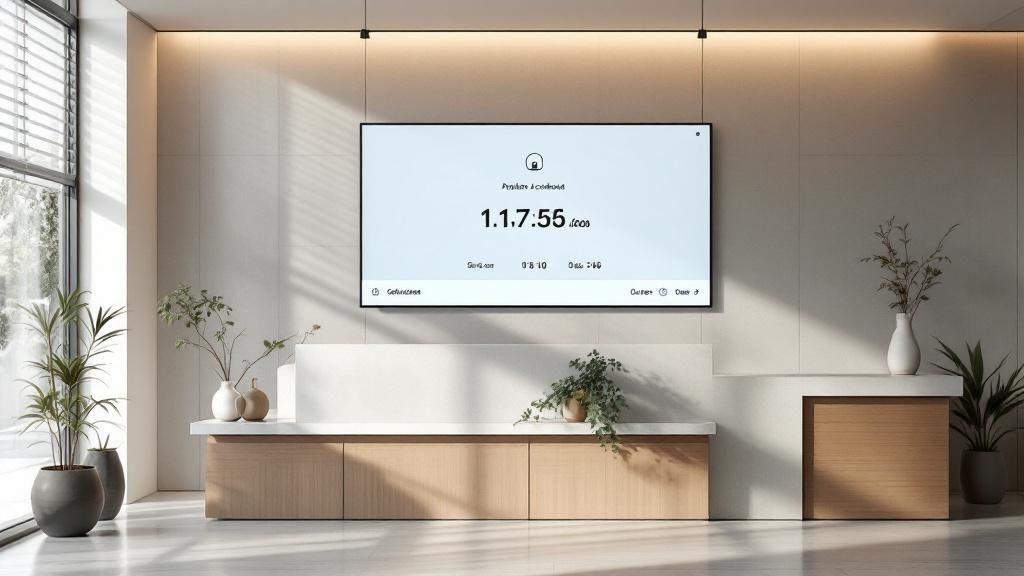In the modern value-based healthcare system, patient satisfaction has become a critical indicator of quality care. This is especially true in specialized fields like wound care, where treatment is often long-term, intensive, and deeply personal. The patient's experience is paramount, directly influencing clinical outcomes, provider reputation, and financial stability.
High satisfaction levels are not just about positive reviews; they correlate with better adherence to complex treatment plans, which can lead to faster healing times and fewer costly complications like infections or hospital readmissions. Achieving this high level of patient trust requires more than just clinical excellence. It demands a deliberate, multi-faceted strategy that places the patient at the very center of every process, from scheduling to discharge.
This article provides a roadmap for that strategy. We will explore seven powerful, evidence-based methods designed to significantly increase patient satisfaction. These actionable insights are tailored for wound care providers aiming to deliver exceptional care and build lasting patient relationships. From personalizing communication and redesigning the care environment to streamlining follow-up, these approaches will help you create a truly patient-centric service that fosters healing and loyalty.
1. Personalized Patient Communication and Engagement
Moving beyond generic, one-size-fits-all interactions is the first crucial step to genuinely increase patient satisfaction. Personalized communication involves tailoring every aspect of your engagement, from the language used in appointment reminders to the format of educational materials, to fit the individual needs, preferences, and health literacy of each patient. This approach transforms the clinical experience from a transactional service into a collaborative partnership, making patients feel seen, respected, and actively involved in their own wound care journey.

This strategy is particularly vital in wound care, where treatment can be long, complex, and emotionally taxing. When a patient with a chronic wound receives follow-up instructions via their preferred method (e.g., a text message with a link to a simple video) instead of a dense pamphlet they can't understand, their adherence and confidence soar. It acknowledges their unique circumstances, building a foundation of trust that is essential for long-term healing.
How to Implement Personalized Communication
Successfully integrating this strategy requires a systematic approach that leverages patient data and feedback.
- Start with a Preference Survey: During intake, ask patients how they prefer to be contacted (text, email, phone call) and what format of educational material works best for them (videos, simple diagrams, detailed text). Also, inquire about language preferences and cultural considerations.
- Leverage Technology: Use your patient portal or EHR system to tag patients with their preferences. Automate communications based on these tags, such as sending multilingual health reminders or customized follow-up care plans, similar to the models used by Kaiser Permanente.
- Train Your Team: Equip all staff, from the front desk to clinical specialists, with skills in active listening and empathy. Training should focus on using teach-back methods to confirm understanding and adapting explanations to a patient's level of health literacy.
Key Insight: Personalization is not just about using a patient's first name in an email. It's about demonstrating that you understand their unique situation and are adapting your care process to support them effectively. As pioneered by leaders like Don Berwick of the Institute for Healthcare Improvement, true patient-centered care begins with honoring individual preferences.
This focused effort directly boosts patient satisfaction by reducing confusion, improving treatment adherence, and fostering a stronger patient-provider relationship, which is the bedrock of high-quality wound care.
2. Reduced Wait Times and Improved Scheduling
Respecting a patient's time is as crucial as the clinical care they receive and is a powerful driver to increase patient satisfaction. Long, unpredictable wait times are a major source of frustration and anxiety, eroding trust and negatively impacting the overall patient experience. A systematic approach to minimizing wait times through optimized scheduling, efficient workflow, and transparent communication transforms a stressful visit into a smooth, respectful, and predictable process.

This focus on efficiency is especially important in wound care, where patients may be in pain, have mobility challenges, or require frequent appointments. When a clinic manages its schedule effectively, it signals to the patient that their time and comfort are valued. This operational excellence, demonstrated by organizations like Cleveland Clinic with their Express Care Online scheduling, directly improves perceptions of care quality and shows profound respect for the patient's journey.
How to Implement Improved Scheduling
Adopting a more efficient scheduling model requires a blend of data analysis, technology, and staff empowerment.
- Analyze and Optimize Patient Flow: Use historical appointment data to identify bottlenecks and peak demand times. Implement buffer times strategically for complex wound care cases or potential emergencies to prevent a cascade of delays throughout the day.
- Embrace Modern Scheduling Tools: Adopt platforms like Zocdoc that offer real-time online booking and automated reminders. These tools empower patients with more control and visibility into the schedule, reducing no-shows and administrative workload.
- Proactively Communicate Delays: Train front-desk staff to keep patients informed of any delays. Offering real-time updates via text message or a waiting room display can significantly reduce frustration by managing expectations. This philosophy is also a core benefit of emerging models; you can learn more about mobile wound care and its importance in eliminating travel and wait times altogether.
Key Insight: Efficient scheduling is not about rushing patients; it's about eliminating wasted time in the process. As lean healthcare pioneers advocate, optimizing patient flow respects everyone's time, including the provider's, allowing for more focused and higher-quality clinical interactions during the appointment itself.
3. Comprehensive Staff Training and Empowerment
The expertise of your clinical team is only one part of the patient experience; the other crucial component is the service-oriented culture they cultivate. Comprehensive staff training is a holistic strategy designed to increase patient satisfaction by developing both clinical excellence and superior patient service skills. This approach empowers every team member, from receptionists to specialists, to resolve issues and enhance the patient's journey, creating a culture where everyone is invested in providing compassionate, effective care.

This model, famously adapted from the Ritz-Carlton's customer service philosophy by organizations like Baptist Health, transforms healthcare interactions. When a patient feels that every staff member is knowledgeable, empathetic, and empowered to help, it significantly reduces anxiety and builds profound trust. In wound care, where treatments can be frequent and stressful, an empowered team can turn moments of frustration into opportunities for reassurance and support, directly impacting a patient's perception of quality. It's a foundational element that supports specialized services, including making the case for why home health care is essential for many patients' recovery.
How to Implement Comprehensive Staff Training
Empowering your team requires a dedicated, top-down commitment to continuous learning and service excellence.
- Model Desired Behaviors: Leadership must visibly champion and practice patient-centered communication and problem-solving. This sets the standard for the entire organization, showing that these values are not just taught but lived.
- Implement Robust Onboarding and Mentorship: Pair new hires with experienced staff who excel at patient interaction. This mentorship, combined with structured training on service standards and empathy, ensures consistency from day one.
- Provide Continuous Education: Schedule regular, mandatory training sessions focusing on communication skills, conflict resolution, and cultural competency. Use real patient feedback and scenarios to make the training relevant and impactful.
- Recognize and Reward Excellence: Create a formal system for acknowledging and rewarding staff who consistently receive positive patient feedback or demonstrate outstanding service recovery. This reinforces the importance of their role in patient satisfaction.
Key Insight: True empowerment means giving frontline staff the autonomy to make on-the-spot decisions that benefit the patient. As Quint Studer, founder of the Studer Group, has shown, when staff are trained and trusted to solve problems, they become proactive advocates for patient well-being, which is the ultimate driver of satisfaction and loyalty.
By investing heavily in your team's skills and sense of ownership, you create a resilient, patient-focused environment that elevates every aspect of the care experience.
4. Patient-Centered Care Environment Design
The physical space where care is delivered has a profound, often subconscious, impact on a patient's emotional and physical well-being. To meaningfully increase patient satisfaction, practices must strategically design their environments to be healing, comfortable, and intuitive. This approach, known as patient-centered or evidence-based design, moves beyond mere aesthetics to create spaces that actively reduce stress, ease navigation, and support patients and their families through what can be a difficult wound care journey.

This concept is crucial in wound care, where patients may face mobility challenges, anxiety, and frequent, long appointments. An environment with clear signage, comfortable and accessible seating, and calming elements like natural light can transform a stressful visit into a reassuring one. For instance, the award-winning healing architecture of Maggie's Centres demonstrates how thoughtful design, including open spaces and views of nature, can significantly improve the patient experience, a principle that directly translates to wound care settings.
How to Implement Patient-Centered Design
Creating a healing environment is an iterative process that blends professional design principles with direct patient feedback.
- Conduct Patient Journey Mapping: Physically walk through your facility from the patient's perspective, from the parking lot to the exam room and back. Identify confusing pathways, sources of stress (like noise or poor lighting), and areas lacking comfort or privacy.
- Involve Patients in Planning: Form a small patient and family advisory committee to provide input on design choices. Ask them about seating arrangements, room layout, and what amenities would make their visits more comfortable. This co-design process ensures changes meet real-world needs.
- Prioritize High-Impact, Low-Cost Changes: You don't need a full renovation to make a difference. Start with simple fixes like improving signage, adding plants, upgrading to warmer lighting, or ensuring waiting areas have accessible power outlets for charging devices.
Key Insight: The environment is an active participant in the healing process, not a passive backdrop. As championed by research pioneers like Roger Ulrich and organizations like Planetree International, evidence shows that elements like views of nature, reduced noise, and clear wayfinding can lower stress, reduce pain perception, and improve overall health outcomes.
By investing in your physical space, you send a powerful message that you care about the patient's entire experience, not just their clinical treatment. This holistic approach is a cornerstone for building trust and achieving higher levels of patient satisfaction.
5. Proactive Patient Safety and Quality Transparency
Fostering an environment of radical transparency around safety and quality is a powerful, yet often underutilized, strategy to increase patient satisfaction. This approach involves openly communicating about your clinic's patient safety measures, sharing performance metrics, and being honest about continuous improvement efforts. When patients see that a practice is committed to excellence and is not afraid to address challenges, it builds profound trust and transforms them into active partners in their own safety.
In the context of wound care, where infection risks are a constant concern, transparency is paramount. Sharing data on infection rates, healing times, and patient-reported outcomes demonstrates a commitment to accountability. This reassures patients that their well-being is the top priority and that the clinic is dedicated to achieving the best possible home health wound care patient outcomes. It shifts the dynamic from one of passive reception of care to active collaboration in a safe, high-quality environment.
How to Implement Proactive Safety and Transparency
Building a culture of transparency requires clear protocols and a commitment from leadership down to every staff member.
- Create a Patient-Facing Quality Dashboard: Develop a simple, easy-to-understand section on your website or in your waiting room that displays key quality metrics. Following the lead of organizations like Johns Hopkins Medicine, showcase data on healing rates, patient satisfaction scores, and infection prevention success. Start with positive metrics to build a foundation of confidence.
- Establish Clear Communication Protocols: Train all staff on how to discuss safety concerns openly and constructively with patients. Develop scripts and protocols for handling situations where a safety event or near-miss has occurred, ensuring communication is empathetic, honest, and solution-focused.
- Involve Patients in Safety Initiatives: Form a Patient and Family Advisory Council (PFAC) to provide feedback on safety procedures and communication materials. As championed by Virginia Mason, involving patients directly in their safety makes them feel valued and provides invaluable insights.
Key Insight: Transparency is not about broadcasting failures; it’s about demonstrating a relentless commitment to improvement. As advocated by patient safety pioneers like Lucian Leape and Don Berwick, when healthcare providers are honest about their performance and improvement goals, they earn the ultimate trust of their patients.
By being proactively transparent, you not only enhance safety but also deeply strengthen the patient-provider relationship, a critical factor in improving overall satisfaction and clinical success.
6. Streamlined Discharge Planning and Follow-up Care
A well-executed discharge process is a powerful tool to increase patient satisfaction, transforming a moment of high anxiety into a confident transition toward recovery. Streamlined discharge planning involves a coordinated approach that begins at admission, not minutes before the patient leaves. It encompasses comprehensive patient education, clear medication instructions, scheduled follow-up appointments, and proactive communication to ensure a seamless continuity of care. This prevents dangerous gaps in treatment and makes patients feel supported long after they have left the facility.
In wound care, where home care is complex and the risk of complications is high, a robust discharge plan is non-negotiable. When a patient leaves with a clear understanding of their wound care regimen, a scheduled follow-up appointment, and a number to call with questions, their confidence is bolstered. This proactive support system, as seen in models like Boston Medical Center's Project RED (Re-Engineered Discharge), drastically reduces readmissions and improves healing outcomes by empowering patients to manage their own care effectively.
How to Implement Streamlined Discharge Planning
A successful discharge strategy requires proactive coordination and clear, repeatable processes.
- Begin Planning at Admission: Treat discharge not as an event, but as a process that starts on day one. Identify potential post-discharge needs, such as home health services or durable medical equipment, early in the patient's stay.
- Use Teach-Back and Visual Aids: Provide clear, written instructions, diagrams, and checklists for wound care. Use the teach-back method to confirm the patient or their caregiver can confidently demonstrate the required tasks, from changing a dressing to identifying signs of infection. You can learn more about how to set up effective post-discharge wound care at home.
- Implement Post-Discharge Follow-up Calls: Schedule a follow-up call within 48-72 hours of discharge. This call is critical for answering questions, reinforcing instructions, and catching potential problems before they escalate.
- Establish Community Partnerships: Create a network of trusted home health agencies, skilled nursing facilities, and community resources. A smooth handoff to these partners ensures patients receive continuous, high-quality care.
Key Insight: The discharge is one of the most memorable and impactful parts of a patient's healthcare experience. As pioneers like Brian Jack and Eric Coleman have demonstrated, investing in a structured, patient-centered discharge process yields immense returns in patient safety, outcomes, and satisfaction.
7. Technology-Enhanced Patient Experience
Integrating digital tools into the care pathway is a powerful method to increase patient satisfaction by meeting modern expectations for convenience and accessibility. A technology-enhanced patient experience uses patient portals, telehealth platforms, and mobile applications to streamline interactions, from scheduling appointments to accessing post-visit summaries. This digital-first approach empowers patients, giving them more control over their healthcare journey and making complex wound care management feel less daunting.

For a patient managing a chronic wound, technology can be transformative. Imagine them using a secure mobile app to send a photo of their wound to their provider for a quick check-in, avoiding an unnecessary trip to the clinic. Platforms like MyChart by Epic Systems have set the standard, allowing patients to view lab results, message their care team, and manage prescriptions from their smartphone. This level of seamless integration significantly reduces administrative friction and improves the overall quality of care.
How to Implement a Technology-Enhanced Experience
A successful rollout requires careful planning focused on usability and support, ensuring the technology serves patients rather than creating barriers.
- Prioritize User-Friendly Design: Partner with patients during the development or selection process of any new tool. Gather feedback on the interface to ensure it is intuitive, simple to navigate, and accessible for users with varying levels of tech proficiency.
- Offer Robust Support: Technology can be intimidating. Provide multiple support channels, such as a dedicated helpdesk phone number, online chat, and in-person tutorials, to assist patients with setup and troubleshooting.
- Maintain Non-Digital Alternatives: Acknowledge that not all patients are willing or able to adopt new technologies. Always maintain traditional options like phone calls for scheduling and paper-based educational materials to ensure equitable access to care for everyone. Exploring solutions that support patients managing care at home can also bridge this gap. You can find more information about at-home wound care and how technology facilitates it.
Key Insight: Technology should be a bridge, not a barrier. The goal is not to replace human interaction but to enhance it by automating routine tasks and freeing up clinical staff to focus on high-value, direct patient care. As leaders at digital health pioneers like Teladoc have shown, technology's greatest impact comes from making healthcare more human-centered and accessible.
By thoughtfully deploying technology, you cater to patient expectations for modern convenience, which directly boosts satisfaction and engagement in their own care.
7 Key Strategies for Patient Satisfaction Comparison
| Strategy | Implementation Complexity 🔄 | Resource Requirements ⚡ | Expected Outcomes 📊 | Ideal Use Cases 💡 | Key Advantages ⭐ |
|---|---|---|---|---|---|
| Personalized Patient Communication and Engagement | High: Requires staff training & tech infrastructure | Significant: Multi-channel tools & training | Improved understanding, compliance, & outcomes | Diverse patient populations needing tailored communication | Enhances trust, reduces readmissions |
| Reduced Wait Times and Improved Scheduling | High: Complex scheduling systems & workflow changes | High: AI scheduling tools & staff training | Shorter wait times & higher patient satisfaction | High-volume clinics aiming to optimize patient flow | Boosts efficiency, reduces no-shows |
| Comprehensive Staff Training and Empowerment | Moderate to high: Continuous training & culture change | Significant: Ongoing programs & coordination | Better interactions, job satisfaction & retention | Facilities focused on service quality improvement | Builds empowered staff, reduces complaints |
| Patient-Centered Care Environment Design | High: Capital investment & phased redesign | High: Renovations, design & maintenance costs | Reduced stress, better recovery & satisfaction | Facilities undergoing renovation or new builds | Improves overall patient experience and healing |
| Proactive Patient Safety and Quality Transparency | Moderate: Communication and reporting processes | Moderate: Training & dashboard tech | Increased trust, safety, & quality improvement | Organizations focused on patient safety culture | Boosts trust, reduces errors through transparency |
| Streamlined Discharge Planning and Follow-up Care | Moderate to high: Coordination & follow-up systems | Significant: Staff time & care coordination | Reduced readmissions & better care continuity | Hospitals with high readmission rates | Enhances recovery support, lowers costs |
| Technology-Enhanced Patient Experience | High: Tech implementation & user adoption challenges | High: Digital platforms & maintenance | Increased convenience, engagement, & efficiency | Systems adopting digital health solutions | Improves access, reduces admin burden |
Integrating Strategies for a Superior Patient Journey
Navigating the path to healing from a chronic or acute wound is a complex process, one where clinical outcomes and personal experience are deeply intertwined. Throughout this article, we've explored seven distinct yet interconnected strategies designed to elevate the patient journey. From the foundational importance of personalized communication and empowered staff to the structural impact of an efficient schedule and a patient-centric environment, each element plays a critical role. The integration of proactive safety measures, streamlined discharge planning, and innovative technology further solidifies a framework for excellence.
The true power of these concepts emerges not when they are implemented as a checklist, but when they are woven together into a cohesive philosophy of care. A successful approach to increase patient satisfaction requires viewing the patient experience as a continuous, holistic journey rather than a series of isolated appointments or procedures. When a compassionate, well-trained team uses technology to enhance communication and a thoughtfully designed environment reduces patient stress, the result is a system that feels supportive, respectful, and highly effective.
From Strategy to System: Creating a Seamless Experience
To transform these individual strategies into a powerful, integrated system, healthcare providers and facilities must focus on the connections between them. For instance:
- Technology and Communication: Use patient portals and telehealth platforms (Strategy 7) not just for convenience, but to deliver the personalized educational content and proactive follow-up discussed in Strategy 1.
- Staff Empowerment and Patient Safety: A well-trained, empowered team (Strategy 3) is your greatest asset in implementing proactive safety protocols and ensuring quality transparency (Strategy 5), as they are the ones on the front lines identifying potential risks and communicating openly with patients.
- Scheduling and Discharge: An efficient scheduling system that reduces wait times (Strategy 2) sets a positive tone from the start, while a well-managed discharge and follow-up plan (Strategy 6) ensures that positive experience continues long after the patient leaves your facility, preventing confusion and improving adherence.
The Ultimate Goal: A Commitment to Better Healthcare
Ultimately, the commitment to increase patient satisfaction is far more than a business metric; it is a fundamental commitment to providing better, more humane healthcare. Satisfied patients are more likely to adhere to their treatment plans, communicate openly about their concerns, and achieve superior clinical outcomes. They become active partners in their own healing.
This integrated model is exemplified by services that bring specialized care directly to the patient’s home. By eliminating the physical and logistical barriers of travel, ensuring consistent and timely communication, and delivering highly personalized treatment plans in a comfortable setting, these at-home models inherently address many of the core principles for boosting patient satisfaction. They offer a tangible blueprint for the future of patient-centric wound management. Embracing these integrated strategies doesn't just build a better practice-it fosters a culture of excellence that benefits everyone involved, leading to healthier patients, more engaged staff, and a stronger, more trusted healthcare organization.
Ready to experience a new standard in patient-centered wound management? Rapid Wound Care brings expert, compassionate wound care specialists directly to your home or facility, embodying the principles of convenience, communication, and quality to increase patient satisfaction. Discover how our at-home model can simplify your healing journey by visiting Rapid Wound Care today.

